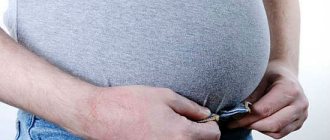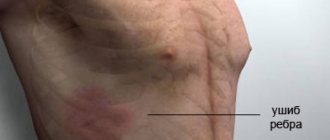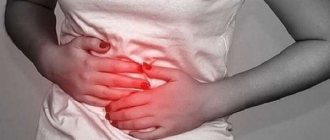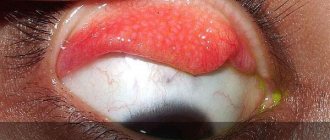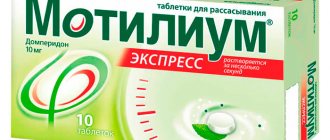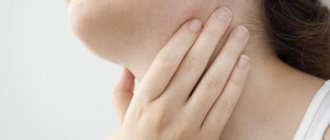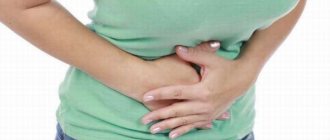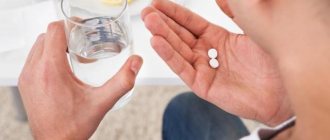The main symptom of pancreatitis is the occurrence of pain due to inflammation of the pancreas. The symptom develops against the background of an ongoing pathological process, directly in the pancreas. As a rule, the pain symptom occurs on the left side, directly under the ribs.
As soon as pain occurs, you should immediately consult your doctor. You should not think that if you eliminate the pain of pancreatitis at home, the symptoms will not appear for some time, then you have gotten rid of pancreatitis.
No, this disease requires complex therapy; you cannot simply take antispasmodic medications.
It is the symptoms of pain during pancreatitis that are the root cause of a significant deterioration in the general well-being of patients with this type of pathology, as well as a predisposing factor for an indispensable visit to a doctor.
Causes
Inflammation of the pancreas is sometimes caused by a hereditary factor. But more often pathology is the result of an incorrect lifestyle. Alcohol, junk food and lack of regular physical activity cause the development of various diseases.
The pancreas is connected to the small intestine by special ducts. Enzymes produced to break down food pass through them. If there is a congenital or acquired pathology of the structure of the ducts, then the process is disrupted. Food is not completely digested and partially accumulates in the gland and stomach.
Pancreatitis is associated with the inability of the gastrointestinal tract to digest certain types of foods. When enzymes fail to break down food, it is not absorbed. This is fraught with the fact that the organ systems do not receive all the microelements that are necessary to maintain normal life. The remains of undigested foods are not excreted into the intestines and provoke an inflammatory process, accompanied by pain.
Due to the pathology of the structure of the ducts, the digestion process is disrupted. Food accumulates and provokes inflammation of the pancreas.
With pancreatitis, varying amounts of enzymes can enter organs and destroy their tissue. Damage to the mucous membranes is accompanied by characteristic pain. With inflammation of the pancreas, severe swelling of the tissues of the internal organs is observed. Squeezing the walls provokes unpleasant sensations. Advanced chronic pancreatitis leads to tissue necrosis, which also does not go away completely for well-being.
The inflammatory process provokes the formation of cysts, fistulas and small ulcers on the gland itself and on adjacent organs. Such pathological changes in pancreatitis are always accompanied by pain.
Prevention and consequences
Prevention of pancreatic pathology consists of observing the following aspects:
- complete exclusion of alcohol and tobacco products from the patient’s life;
- timely consultation with a doctor when the first unpleasant symptoms appear in the epigastric area;
- organizing a proper and balanced diet;
- maintaining a healthy lifestyle;
- take evening walks before bed;
- eliminating night snacks;
- avoiding overeating and hunger strikes;
- timely treatment of all pathological disorders in the gastrointestinal tract.
If all the above aspects and recommendations of the attending physician are observed, each patient will be able to feel full of strength, health and live many more happy years.
Pain in the right side can be caused by diseases not only of the abdominal organs, but also of the respiratory system (bronchitis, pneumonia, pleurisy, pneumothorax, lung cancer), heart and circulatory system (rheumatic carditis, arterial hypertension, thrombophlebitis, pericarditis, pre-infarction condition), peripheral nervous system (arachnoiditis, myelitis, ganglionitis, epilepsy) and other reasons, even to the point that a person carries a bag on his right shoulder or sleeps on his right side on a hard mattress.
That is why only a specialist can answer the question of why the pain occurred and make the correct diagnosis by comparing several factors. He must also prescribe therapy to eliminate the painful sensation, which, depending on the diagnosis, may include physical therapy, medication, IVs, and injections.
Prevention of exacerbations of pancreatitis is quite simple. As well as preventing the occurrence of the disease itself.
To prevent the development of pancreatic inflammation, you should not only adhere to a healthy diet, but also follow a daily routine. It is not recommended to eat at night, this is due to the fact that during this period of the day the organ goes into a slow mode of functioning.
You should not eat fast food, you also need to reduce your consumption of alcohol, fatty and fried foods. It is advisable to use boiled and baked meat for food. Additionally, it is necessary to limit the consumption of flour products and sweets.
Before taking part in the feast, to facilitate the work of the body, it is necessary to take enzymatic preparations that contain amylase, one of the main enzymes produced by the pancreas.
In order to promptly seek help and identify the presence of a disease in the body, you need to know what the first signs of the disease are.
Such signs are the following:
- sharp or aching pain in the abdominal area;
- girdling pain in the lumbar region;
- the appearance of a feeling of nausea and vomiting;
- the appearance of aversion to any food;
- the occurrence of bloating;
- change in skin color;
- decreased blood pressure;
- increase in heart rate.
If pancreatitis is suspected or the first signs of the disease appear, a comprehensive examination should be carried out to establish an accurate diagnosis.
When carrying out diagnostics, the following examination methods are used:
- Conducting a laboratory blood test.
- Blood chemistry. This test reveals the level of amylase in the blood.
- X-ray of the abdominal organs.
- Fibrogastroduodenioscopy. The use of this technique makes it possible to determine the presence of ulcers and neoplasms; in addition, the method allows one to obtain the patient’s gastric juice for analysis.
- Laparoscopy. The method allows, if necessary, to take material for a biopsy. A biopsy makes it possible to detect the presence of cancer cells if there is suspicion of cancer development.
- Computed tomography is performed if a pancreatic tumor is detected.
One of the most common methods for detecting pathology is ultrasound.
You should not eat fast food, you also need to reduce your consumption of alcohol, fatty and fried foods. It is advisable to use boiled and baked meat for food. Additionally, it is necessary to limit the consumption of flour products and sweets.
Such a pain
The nature of the spasm in acute and chronic pancreatitis differs in intensity. In the first case, the attack does not go away after a short time. A person experiences severe pain that cannot be tolerated without taking medication.
A person experiences severe pain that cannot be tolerated without taking medication.
The chronic course of the disease is characterized by varying manifestations of symptoms. The nature and intensity of pain are associated with:
- with the frequency of remissions and exacerbations;
- degree of damage to pancreatic tissue;
- the patient's lifestyle.
Constant spasms in acute pancreatitis are relieved in a hospital setting. Sometimes people suffering from pancreatitis experience “hunger” pains. The state of health worsens sharply in the morning before eating. This syndrome occurs with an ulcer. This pathology is sometimes concomitant with pancreatitis, as it develops against its background.
People suffering from pancreatitis experience “hunger” pains. Feeling worse in the morning before eating.
The spasm may manifest itself at night in the form of a dull or aching pain. This condition occurs especially often in patients who do not adhere to a strict diet or eat heavily before bed. A weakened pancreas cannot completely digest food, and at night all processes in the body slow down. This creates additional stress on the damaged organ and provokes spasms.
During the period of exacerbation of chronic pancreatitis, patients note that a dull girdle pain occurs after eating. If a person has consumed foods prohibited for inflammation of the pancreas, then the negative sensations intensify.
Burning sharp spasms are a reason to immediately seek medical help.
What does the nature and localization of sensations say?
The localization of pain in pancreatitis is of great importance. Doctors recognize that pain is localized according to the individual characteristics of the patient, but the nature also indicates the extent of the inflammation.
Acute and chronic pain are different.
Acute form
Pain syndrome occurs some time after consuming a product not permitted by the diet. The longer the inflammation lasts, the stronger the pain - often the patient cannot sleep at night, constantly tossing and turning in bed, trying to find a position that can reduce the pain. Particularly unpleasant sensations occur when lying on your back.
An acute pancreatic attack is recognized by characteristic pain in the upper abdomen. This is the center of the epigastric region. Sometimes the pain radiates to the left hypochondrium. In rare cases, an attack of pancreatitis resembles angina pectoris in its manifestations: burning pain is felt behind the chest, as if increasing the body temperature from the inside, and the part of the body on the left side of the person feels unpleasant sensations: the left shoulder blade, arm, lower jaw on the left.
Chronic form
In the chronic stage, it is difficult to mark clear locations of pain due to the blurriness and uncertainty of sensations. Painful sensations are detected:
- at the top or in the middle of the abdomen (almost in the umbilical region);
- in the lower ribs (in the lower thoracic region);
- in the back – no irradiation;
- encircling in nature, involving the back and sides in a full or semi-full circle.
The pain takes on a cramping character: it appears, then suddenly disappears. The intensity varies, but more often patients report such a high degree of pain that it leads to mental disorders. In this case, localization does not matter.
You should not be happy if major pain syndrome goes away on its own. The pancreas is no joke - if the organ is silent, it means that most of it has already died. It is impossible to return what has been lost, therefore, digestion will begin to deteriorate sharply.
How long does it last
Pain from pancreatitis sometimes resembles symptoms of other diseases. However, some manifestations make it possible to distinguish spasms associated with pancreatic pathology. Despite the fact that the pain spreads to various parts of the body, with pancreatitis it intensifies only with palpation of the abdomen.
Despite the fact that the pain spreads to various parts of the body, with pancreatitis it intensifies only with palpation of the abdomen.
Cramps most often begin after eating. They last continuously. When it comes to exacerbation of pancreatitis, pain cannot be relieved without medical help. The duration of the attack is determined by the occurrence of secondary symptoms, which appear 2 hours after the onset of the acute phase.
Continuous vomiting with bile, loose stools, sour taste, chills and high temperature against the background of severe constant pain in the epigastrium, back and sternum is a reason for immediate hospitalization of a patient diagnosed with acute pancreatitis. It is impossible to relieve an attack at home.
How to relieve an attack of pancreatitis at home? First aid
The key process of chronic pancreatitis is the replacement of gland tissue with connective tissue. Sometimes salt compounds, often calcium, settle in the connective tissue, clogging the ducts of the gland (calculous pancreatitis). The closed ducts continue to function, accumulating fluid, forming cysts. When an exacerbation of pancreatitis occurs, dull pain appears in the area under the stomach, increasing after a diet violation.
More often, the sensations occur after heavy feasts or an excessive amount of food eaten. This happens due to the expansion of the stomach, pressing on the head of the pancreas, causing spasm, leading to pain. It occurs under the stomach, it feels deep in the abdomen. Depending on the eating disorders, the pain is short-term or becomes permanent.
The pain spreads to the area of the left sternum, affecting the shoulder, spreading to the back. If the disease progresses in the head of the gland, it spreads to the liver area. If the pathology affects the entire organ, the pain encircles.
There is an increase in pain in certain positions of the patient - lying on his back. Becomes weaker when sitting. Instinctively, the patient presses his legs to his chest in a sitting position - with this position the pain weakens.
According to statistics, with chronic pancreatitis, pain is observed in 9 out of 10 patients, and only 1 in 10 pancreatitis is not accompanied by painful sensations.
The attacks may recur. Doctors have created a scale of attacks:
- Type A. Pain lasts up to 10 days, interspersed with long periods without it.
- Type B. Long periods of pain up to 30-60 days. This type is more common in alcoholic pancreatitis.
- Persistent, ongoing pain. It is an indication for surgical intervention and the use of narcotic painkillers.
The answer to the question of how long an attack of pancreatitis lasts lies in the stage of pancreatitis and aspects of development. Violation of the outflow of pancreatic juice and an increase in pressure in the lumen of the duodenum lead to the reflux of contents into the gland duct. The duct is not designed for this; small breaks occur, into which active bile enzymes from the intestines enter. They activate their own pancreatic enzymes. The process of inflammation and destruction of pancreatic tissue begins.
Pain in chronic pancreatitis varies. Dull infrequent accompanies patients who violate their diet due to illness.
A different type of pain is acute, with intensification, without spasm. Women are more often haunted by pressing pain after eating. According to statistics, in women, pancreatitis is often combined with biliary tract disease. Pain after eating the wrong food goes away after 2-3 hours and occurs in periods with a chronic course.
Consuming alcoholic beverages and fatty (fried) foods with a weak pancreas contributes to exacerbation of pancreatitis, so the basis of any therapy becomes a therapeutic diet with a selective list of foods. In addition to alcohol consumption, the causes of this disease are presented in the following list:
- limited portions of protein foods;
- nervous shocks, stressful situations;
- acute infectious diseases;
- hereditary factor;
- smoking and other bad habits;
- consequence of drug therapy;
- relapses of cholecystitis, cholelithiasis, cholangitis;
- exposure to toxic, toxic substances;
- systematic overeating (excessive food load);
- chronic diseases of the liver, duodenum;
- old age;
- complications after surgery;
- autoimmune diseases;
- mechanical abdominal injuries.
Relapse begins with acute pain in the abdominal area, the localization of which is difficult to determine. In the absence of timely conservative therapy, the unpleasant feeling of pain only intensifies, the same thing happens after eating food and systematic overeating. To correctly differentiate exacerbation of pancreatitis, it is important to know its clinical manifestations:
- nausea, prolonged bouts of vomiting;
- vague feeling of pain, severe heartburn;
- rumbling, bloating, flatulence;
- severe signs of dyspepsia (weak stools, diarrhea);
- disruption of the endocrine system;
- increased body temperature, fever;
- dryness, bitterness in the mouth;
- lack of appetite, sudden weight loss;
- depression of the nervous system;
- nagging pain in the back of uncertain localization.
The disease is difficult and takes a long time to treat with medications; it requires an integrated approach to the health problem. The main goal of treatment is to relieve pain, restore the concentration of pancreatic juice, relieve the pancreas and prolong the period of remission. To achieve the desired result, you must strictly adhere to these valuable expert recommendations:
- It is important to provide the patient with complete rest and reduce physical and emotional stress, especially during the next exacerbation.
- Strictly adhere to a therapeutic diet with strict limitation of fatty, fried, salty, smoked and spicy foods.
- The first two days of the exacerbation stage require you to completely stop eating and choose therapeutic fasting.
- Cold must be applied to the suspected affected area to ease general well-being and get rid of unbearable pain.
- It is important to control the flow of fluid into the body, regularly take medications such as Bourget's mixture for heartburn, Almagel, Gordox, Contrical against inflammation.
- Regular intake of natural vitamins or full-course multivitamin complexes is encouraged.
In the event of an attack of acute pain, action must be taken immediately. Oral intake of antispasmodics, analgesics, enzyme preparations, prokinetics, non-narcotic analgesics is encouraged on the individual recommendation of the attending physician (depending on the severity of symptoms in a specific clinical picture). Other medications are especially popular for exacerbation of pancreatitis, which should be taken in full course:
- H2-histamine blockers: Ranitidine, Famotidine;
- proton pump inhibitors: Omeprazole, Rabeprazole;
- to suppress pancreatic secretion: Somatostatin and Octreotide;
- anti-enzyme drugs: Kontrikal, Gordox.
- pancreatic enzymes: Creon, Pangrol;
- prokinetics: Motilium, Cisapride;
- anticholinergics: Atropine, Metacin, Platiphylline;
- antispasmodics: Drotaverine, No-shpa, Papaverine;
- non-narcotic analgesics: Metamizole sodium, Analgin, Paracetamol, Ketorolac;
- opioid analgesics: Tramadol, Promedol, Meperidine.
The above medications can only be prescribed by your doctor. Unauthorized choice of a complex treatment regimen can provoke an exacerbation of another disease of the digestive system (in addition to pancreatitis), side effects, acute signs of intoxication, and the risk of drug interactions. In addition to the pharmacological groups presented, it is important not to forget about the benefits of vitamin therapy and a therapeutic diet.
Exacerbation of chronic pancreatitis does not always respond to successful conservative treatment; in some clinical situations, doctors insist on urgent surgery. It is first necessary to undergo a detailed diagnosis of the body to exclude potential health complications. After surgery, a rehabilitation period for pancreatitis is required, lasting from 3 to 6 months with the participation of drug therapy. Surgical methods are presented below:
- Straight. Provides definitive removal of stones, pancreatic resection and drainage of pseudocysts.
- Indirect. Surgical intervention is performed directly on the gastrointestinal tract and bile ducts, after which the condition of the pancreas improves significantly.
Conservative or surgical treatment of the disease must be timely and correctly selected. If you ignore the pronounced symptoms of exacerbation of pancreatitis or self-medicate for a long time, you can provoke serious health complications, sometimes incompatible with the patient’s life (for some patients they can result in death). Potential pathologies are presented in the following comprehensive list:
- internal bleeding;
- icteric cholestasis;
- thrombosis of the splenic veins;
- formation of pseudocysts;
- hypovolemic shock;
- infectious lesions of the body (abscesses);
- distress syndrome;
- renal failure;
- encephalopathy;
- pancreas cancer.
It is recommended to prevent the disease in a timely manner, and to do this, take preventive measures. This is especially true for patients at risk, the elderly. Otherwise, treatment of chronic pancreatitis in the acute stage is very complicated, does not give the patient the most pleasant sensations, and an acute attack of pain is difficult to stop. Here are the generally available preventive measures we are talking about:
- give up smoking, drinking alcohol, and other bad habits forever;
- It wouldn’t hurt to play sports or take long walks in the fresh air;
- normalize the functioning of the digestive system (cure constipation or diarrhea);
- control body weight, avoid the development of obesity and frequent overeating;
- take vitamin complexes several courses per year;
- for prevention purposes, use multienzyme drugs for 6 months after an exacerbation;
- adhere to a therapeutic diet (limit consumption of fatty, fried, spicy foods);
- drink only mineral water;
- avoid stressful situations;
- reduce the risk of mechanical injuries;
- strengthen local immunity.
By adhering to such simple recommendations, you can exclude exacerbation of pancreatitis for an indefinite period of time. Keeping your problem in mind, preventive measures should become the norm of everyday life for the patient. Otherwise, effective treatment of exacerbation of chronic pancreatitis takes a lot of effort and significantly undermines the general condition of the nervous system.
An attack of pancreatitis often resembles manifestations of diseases of the hepatobiliary system, kidneys, stomach and duodenum. The patient suffers from vomiting, nausea, and dyspepsia. Acute pancreatitis is distinguished from all pathologies of the digestive tract by the suddenness of the onset of an attack.
Chronic pancreatitis is characterized by painful manifestations, usually without nausea and vomiting - sometimes the stomach just hurts, at times it hurts very badly, but there is no nausea and vomiting. The pain with pancreatitis is very intense, it quickly covers all the insides. In acute pancreatitis, rapid exhaustion occurs, repeated vomiting does not provide relief, bile and a greenish liquid are observed in the vomit.
Where does it hurt with pancreatitis?
The localization of spasms during inflammation of the pancreas depends on which part of the organ is damaged. Patients themselves often cannot pinpoint the area of the body where the pain is most acute. However, doctors say that the main source of spasm is in the epigastric region. And the points where the pain radiates can be different.
Doctors say that the main source of spasm is in the epigastric region.
This peculiarity of the course of the disease is explained by the location of the pancreas. It is located behind the stomach, closer to the lumbar region. Several large plexuses of nerve roots are concentrated around the organ, including spinal areas. The inflammatory process covers adjacent areas. Tissue swelling causes the pancreas to put pressure on the nerve endings. Therefore, the spasm spreads to various parts of the body.
Pain in right side
Pain in the right side often appears after heavy libations, a heavy lunch, dinner with fried, fatty foods.
But not all problems are always in the liver, as is usually believed. Doctors generally assure that very often the liver has nothing to do with it. She can't get sick at all. Perhaps with cirrhosis, hepatitis, if it is overly stretched or very dense. These are chronic diseases that patients themselves are often well aware of. But, if frequent spasms occur for the first time, you need to be examined by a therapist.
When you feel pain on the side and you decide that the situation is bearable and you don’t need a doctor, you can drink Noshpa. But when pain is accompanied by fever, you should not pretend to be Hippocrates. It is in your best interests to quickly surrender to the mercy of the doctors.
Intercostal neuralgia
Damage to pancreatic tissue in the area of the tail of the pancreas leads to the development of pain in the lower left part of the peritoneum. The spasm resembles neuralgia. The organ swells and compresses the nerve endings. As a result, the pain is concentrated in the left hypochondrium.
If the focus of inflammation in pancreatitis is localized in the area of the head of the gland, then the spasm spreads to the right side of the abdominal cavity. Its intensity depends on the extent of organ damage and the presence of concomitant diseases. But the main area of pain is located in the right hypochondrium.
If the source of inflammation is located in the area of the head of the gland, then the spasm spreads to the right hypochondrium.
Sometimes patients complain of heaviness and spasms in the chest, reminiscent of the effects of angina pectoris. However, heart pain has a wave-like character. Short periods of exacerbation are followed by moments of relief. With pancreatitis, the spasm is characterized by continuous intensity. When palpated in the peritoneal area, the sensation intensifies. Therefore, an experienced doctor will immediately recognize inflammation of the pancreas when examining a patient.
Nature of the symptom
Any pain indicates health problems, and ignoring the symptom is dangerous. Whether a person requires emergency hospitalization or should undergo medical diagnostics on an outpatient basis depends on the nature of the pain manifestations.
Aching
When the right side ache, this is a sign of sluggish chronic inflammation. Depending on the location, aching pain will indicate the following diseases:
- Cholecystitis. With chronic inflammation of the walls of the gallbladder, the right hypochondrium aches, and the discomfort intensifies when a person eats fatty, spicy or spicy foods.
- Colitis. The inflammatory process of the colon mucosa provokes aching painful sensations in the lower abdomen on the right.
- Chronic adnexitis. In women with ovarian pathology, pain occurs in the groin on the right. The resulting painful sensations radiate to the coccyx or lumbar spine.
- Kidney diseases. Chronic renal inflammation is characterized by a dull aching pain in the right back.
In terms of intensity, aching pain in the right side can be either pronounced or barely noticeable, causing moderate discomfort.
Pulling
A feeling of pulling on the right side most often appears when the functioning of the digestive organs is disrupted. The reason may be:
- Chronic cholecystitis. Constant inflammation of the walls of the organ reduces the contractile function of the gallbladder and leads to stagnation of bile. People complain that there is a pulling on the right side under the ribs. Patients often complain of morning sickness and stool upset (diarrhea, constipation).
- Liver diseases. In the subacute course of liver pathologies, it pulls under the costal arch in front. The patient develops an unpleasant bitterness in the mouth and stools are disturbed. In severe functional disorders, the skin becomes dry, jaundice and/or rashes appear.
In women, nagging pain in the lower right occurs with an ovarian cyst.
Often, during unusual physical exertion (running, fast walking) or after eating a large amount of heavy food, a person experiences an unpleasant pulling sensation on the right side. The appearance of the sensation is associated with increased load on the liver.
Burning
When this symptom appears, it is difficult to determine what may be hurting. A burning sensation in the right side occurs with pathologies of almost all organs.
- gallbladder (cholelithiasis, cholecystitis);
- pancreas (exacerbation of chronic pancreatitis);
- appendicitis.
A burning sensation on the right can appear with diseases of the spine, intercostal neuralgia, and neoplasms.
Dumb
There are many reasons why a dull pain appears on the right side. The symptom provokes:
- consequences of injuries;
- inflammation of ligaments, bones or internal organs;
- neurological diseases.
The appearance of dull pain is possible at the initial stage of appendicitis. Patients complain that the right side hurts, where the ribs are and near the navel.
Sharp and sharp
When sharp pain suddenly appears, an acute pathological process should be suspected. Depending on the location, the cause of the syndrome will be:
- pancreatic necrosis and acute pancreatitis;
- intestinal diverticulum;
- strangulated hernia;
- intestinal obstruction;
- duodenitis;
- functional disorders in the liver or gall bladder;
- bladder diseases;
- inflammation of the appendicular process:
- pinched nerve root (for diseases of the spinal column).
Acute pain in the right hypochondrium occurs with intercostal neuralgia and herpetic eruptions (shingles).
Severe pain that appears suddenly indicates acute functional impairment and requires emergency assistance. Ignoring the condition that has arisen is dangerous - lack of help leads to dangerous complications, and in severe cases ends in death.
Stabbing
The intensity of pain varies. Sometimes the patient complains that there is a tingling sensation in the right side, and sometimes there is unbearable pain.
What triggered the development of pain can be assumed, taking into account the localization and accompanying symptoms.
- Biliary or hepatic colic. Appears due to spasm of the bile ducts or when stones formed in the organ cavity are displaced. It stings in the right hypochondrium and an unpleasant bitter taste appears in the mouth. The pain radiates to the shoulder or shoulder blade.
- Renal colic. Stitching pain occurs in the lumbar region and radiates to the groin. There are problems with urination: the amount of urine released decreases, an unpleasant odor and blood appear. The appearance of renal colic causes the movement of sand or stones formed in the kidney.
- Intestinal colic. In infants, the appearance of the symptom is associated with the immaturity of the digestive tract and nutritional errors of the nursing mother. In adults and children over one year of age, colic appears due to acute and chronic pathologies of the stomach or intestines. Colic is accompanied by increased formation of gases and bloating of the peritoneum. Pain in the iliac region and at the level of the navel on the right.
With severe stabbing pain, patients cannot tolerate the discomfort that arises and seek help from doctors, but moderate tingling pain is often ignored. But the occurrence of prolonged tingling sensations in the side on the right is often the “first call”, indicating the development of pathological abnormalities. Lack of treatment gradually provokes the development of severe pain and the appearance of painful colic.
Pulsating
The feeling of unpleasant pulsation suggests the development of the following conditions:
- purulent inflammation. Abdominal wall abscesses or gangrenous appendicitis cause a feeling that something is pulsating and twitching in the right side.
- abdominal aortic aneurysm. Pathological expansion of part of the vascular wall leads to throbbing pain due to blood pressure. The most common cause of pathology is intravascular cholesterol deposits.
The development of an aneurysm occurs slowly, and the pulsation increases gradually, causing painful discomfort. Purulent processes develop faster and are accompanied by general intoxication (weakness, fever, headaches).
Discomfort
In healthy people, discomfort in the right side can be provoked by the following factors:
- unusual physical effort;
- binge eating;
- prolonged stay in an unnatural position.
Discomfort in the right side, caused by physiological reasons, quickly disappears without the use of medications.
When discomfort persists constantly, it is worth suspecting the onset of a pathological process in the digestive system. The initial stage of the disease often begins with the appearance of moderate discomfort, and then, as functional abnormalities in the functioning of organs increase, pain appears.
In the abdominal area
The epicenter of pain is the abdominal area. Inflammation of the head of the pancreas provokes negative manifestations in the right side. The presence of stones and cysts in the upper part of the gland intensifies these symptoms.
Undigested food may partially remain in the stomach, irritating it. A concomitant disease of pancreatitis is gastritis. Patients are often diagnosed with biliary dyskinesia, duodenal ulcer and cholecystitis.
A concomitant disease of pancreatitis is gastritis.
An acute attack of pancreatitis is characterized by spasms in the left side, when the tail part of the pancreas and adjacent tissue are affected. The pain radiates to the lower abdomen. The patient's condition is aggravated by the fact that the accumulation of poorly digested food contributes to the development of putrefactive processes in the intestines. This threatens an extensive inflammatory process and poses a threat of infectious infection.
How to relieve an attack of pancreatitis at home: tips, first aid
Young men aged 18-39 years are susceptible to attacks of alcoholic pancreatitis. Women aged 60-85 years are susceptible to attacks of biliary pancreatitis.
The onset of an attack always sharply worsens the quality of life, general well-being, and complaints appear. It is necessary to “recognize the enemy and neutralize” in time.
Timely assistance is the key to maintaining human health. How to relieve an attack of pancreatitis at home? Is it possible? What is the right thing to do?
The evolution of an attack of acute pancreatitis consists of the following stages: acute attack, subsidence of the attack, resolution (recovery or the formation of complications, transition to a chronic version), repeated acute attack.
The most common causes that can provoke an acute attack of pancreatitis include: alcohol, large meals, pathology of the gallbladder and its ducts, traumatic injury, surgery, biopsy, pancreatic oncology (cancer), high cholesterol levels (hyperlipidemia).
- Rare causes include: medications, vascular pathology, autoimmune diseases, infections (viruses, HIV, worms, etc.), allergies, snake bites, hereditary pancreatitis, pregnancy, pathology of neighboring organs, as well as idiopathic pancreatitis (when the cause cannot be determined succeeds).
The essence of the occurring disorders is the self-destruction of the pancreas under the influence of its own pancreatic enzymes. General phenomena are associated with the entry of digestive enzymes into the bloodstream with the development of systemic damage.
acute pain (pancreatic colic),
- temperature rise,
- increased heart rate and breathing,
- nausea and possibly vomiting,
- sometimes jaundice.
Abnormalities in laboratory tests are recorded. A blood test records an increase in the level of leukocytes, with a shift in the leukocyte formula to the left, a decrease in lymphocytes, and an increase in ESR.
Detection of inflammatory markers in blood biochemistry, increase in C-reactive protein and fibrinogen, etc. There is an increased level of pancreatic enzymes in blood biochemistry: amylase, lipase, elastase, trypsin.
- Hardware methods (MRI, CT, ultrasound) are useful for diagnosis.
- The more severe the attack of pancreatitis, the more complaints and more pronounced abnormalities in the tests.
- It is imperative to exclude diseases with similar complaints to exclude errors: myocardial and intestinal infarction, perforated gastric ulcer, cholecystitis with stones and acute cholecystitis, rupture of the aorta, renal colic and other causes.
- Additionally, other symptoms may occur, but less frequently: symptoms of intestinal obstruction, bloating and gas formation (flatulence), dehydration, symptoms of shock, heart or kidney failure.
- Less common symptoms include fluid accumulation in the abdomen (ascites), pleural (lungs) and pericardial (pericardial) cavity, decreased calcium levels in the blood, subcutaneous areas of destruction and suppuration, thrombosis of the internal veins, bleeding disorders, brain damage and blindness.
Attacks of acute pancreatitis are classified by severity: mild, moderate, severe. This is important for further treatment and prognosis.
- An acute attack of mild pancreatitis is expressed in minimal manifestations of damage to the pancreas. There is little dysfunction. The structure of the gland rarely changes when monitored using CT (computed tomography). Normalization of the condition occurs within three days. Complications are not recorded. Ends successfully with complete restoration of function. This degree is detected in 50% of sick people. An attack of pancreatitis may recur if the cause is not eliminated.
- About 25% of people experience a moderate attack. Sometimes complications form (pseudocysts, inflammation and compaction around the gland, purulent melting of the gland). It is possible that other organs may be affected and their functioning may be impaired; this condition lasts up to 2 days.
- The remaining 25% of people develop a severe attack of pancreatitis. It is characterized by extensive damage to the pancreas and surrounding organs. Venous bleeding, respiratory failure, and renal failure develop. Life-threatening condition. Complications are found extremely often (cysts, pseudocysts of the gland, necrosis and suppuration of the gland, coagulation disorders, electrolyte imbalance). This attack lasts over two days.
Primary care consists of assessing the patient's condition and seeking medical help. Do not feed, do not drink, ensure peace!
It is possible to find out the reasons preceding the deterioration of the condition (alcohol intake, overeating, trauma, cholelithiasis, etc.).
This category of people must be urgently transported to the surgical department; in such situations, it is recommended to call an ambulance “03”.
The emergency doctor “03” can reduce pain by administering painkillers, antispasmodics and anti-inflammatory drugs.
If you notice the development of symptoms of an attack of pancreatitis, then treatment at home is contraindicated! During an acute attack, antispasmodics (no-spa) do not relieve pain! This is another factor in favor of contacting a doctor or surgeon as soon as possible.
In the emergency department, the necessary tests are quickly taken and an ultrasound and CT scan (of the abdominal cavity) are performed. Further, based on the results, the doctor makes a conclusion about the diagnosis and further treatment. Further treatment must be carried out in a hospital.
- At the initial stage, treatment is carried out with medications; surgery is performed if complications develop.
- The benefit of treatment is greater if treatment is started early, in the first 24 hours from the onset of the attack.
- Evolution of an attack of chronic pancreatitis: exacerbation, subsidence of exacerbation, resolution (remission, formation of complications).
The key complaint during an attack of chronic pancreatitis is pain. Attacks of pain may change over time, the intensity of attacks, their location, and the involvement of nearby organs in the process.
The pain can be in the right side, left or in the middle, and can take on a girdling character due to inflammation of the intestinal loops. The pain appears immediately after or half an hour after eating.
Eating is a trigger for pain. During the diagnostic search, the presence of complications and signs of chronic pancreatitis are revealed.
Insufficient production of pancreatic enzymes is expressed in the following symptoms: diarrhea or loose stools, release of large amounts of feces, bloating, flatulence, abdominal discomfort, loss of appetite, fatty feces, salivation, belching, nausea, repeated vomiting.
Late symptoms include the development of pancreatogenic diabetes mellitus and increased insulin.
In the process of compression of the intestine, intestinal obstruction occurs. Jaundice is diagnosed when the gallbladder duct is compressed or blocked by a stone. Compression of the hepatic and splenic veins leads to ascites, an increase in the volume of the spleen, and varicose veins.
But with chronic pancreatitis, even during an exacerbation, the patient can stay at home. Especially if he has had the disease for a long time, and he has all the necessary medications.
If you start taking measures on time and follow all the principles of treatment, you can quickly stop the attack and avoid complications.
At my feet
General weakening and exhaustion of the body against the background of constant pain during an exacerbation of pancreatitis provokes the spread of unpleasant sensations throughout the body. The leaching of calcium and other trace elements contributes to the development of diseases of the nervous system and musculoskeletal system.
Migraines may develop with pancreatitis.
Patients complain of severe migraines. People suffering from pancreatitis often experience joint pain. The concentration of unpleasant sensations is observed in the area of the knee and elbow bends.
Elimination of pain symptoms in a hospital setting
In case of severe pancreatitis, the patient must be urgently hospitalized. In the hospital, narcotic analgesics are used to relieve pain. Usually used:
- "Tramadol";
- "Omnopon";
- "Ketanov";
- "Promedol."
In particularly difficult situations, such analgesics are combined with antidepressants, tranquilizers, and antipsychotics, since these drugs enhance each other’s effect on the body.
How and with what to relieve pain
Exacerbation of chronic pancreatitis and severe forms of this disease are life-threatening. When the first symptoms of pathology appear, you should immediately consult a doctor. It is impossible to relieve an attack at home. However, it is necessary to alleviate the patient’s condition before the ambulance team arrives.
If a person is not entirely sure that the pain syndrome is associated with inflammation of the pancreas, then you should not take antispasmodics on your own. The effect of the medications will ease the discomfort, and the doctor may make a mistake when making a diagnosis, since in most cases, exacerbation of chronic pancreatitis is determined during examination by palpation of the abdominal cavity.
If a person is not entirely sure that the pain syndrome is associated with inflammation of the pancreas, then you should not take antispasmodics on your own.
Partial pain relief occurs when the patient takes a horizontal position and applies ice to the area of the left hypochondrium and intestines. Cold promotes the onset of relief until qualified medical assistance is received. The patient should refuse food during the attack.
How long does pain with an inflamed pancreas last?
This question is very difficult to answer. It is impossible to say exactly how long the pain with this disease will last. But there is a certain classification.
When painful sensations with high intensity suddenly stop their manifestation and the patient’s condition quickly normalizes, this may not be a reason for joy, but for additional diagnostic procedures.
In the first case, the symptom can last for 10 days, while a long-term remission is observed.
In the second case, the patient’s pain lasts for 30-60 days. The pain syndrome is long-lasting, so it most often speaks of alcoholic pancreatitis.
If it does not stop even after taking medications, then this is an indication for surgery.
During pregnancy
During pregnancy, the growing uterus puts pressure on other organs. Changes in a woman’s body caused by hormonal changes also contribute to the exacerbation of chronic diseases. Pancreatitis is on the list of the most common pathologies that appear during pregnancy.
Exacerbation of the disease contributes to increased toxicosis. The inflammatory process in the pancreas is accompanied by pain, and against the background of a general weakening of the immune system, it can even provoke a miscarriage.
Exacerbation of the disease contributes to increased toxicosis.
Taking various medications without a doctor's prescription is prohibited for a pregnant woman, since the active ingredients of the medications or any components included in their composition pose a threat to the fetus.
Therefore, if pancreatitis worsens, the expectant mother must be quickly taken to a medical facility, where specialists will stop the spasm and stop the inflammatory process using medications approved during pregnancy.
Ectopic pregnancy or cyst
In the fair half, pain under the ribs may suggest a diagnosis of “ectopic pregnancy.” But this also happens when the genitourinary tract is infected. In more complex and unpleasant cases, this may be caused by a growing tumor or a ruptured cyst in the ovary.
But very often everything is not so bad - perhaps your period is just approaching. Meetings with a specialist: a gastroenterologist, an infectious disease specialist, a surgeon, a gynecologist and a traumatologist will help you avoid unpleasant sensations in the future.
Which doctor should I contact?
Pancreatitis refers to diseases of the gastrointestinal tract. Gastroenterology deals with these pathologies. An attack of acute pancreatitis is a reason to call an ambulance in order to relieve pain and prevent the development of peritonitis or bleeding.
The patient will be treated by a gastroenterologist.
Further treatment of the patient will be carried out by a gastroenterologist. With cholecystitis and pancreatitis, a large number of concomitant diseases are diagnosed, including diabetes mellitus. Therefore, a person may be referred for consultation with an endocrinologist and other specialized specialists.
Acute pancreatitis and chronic pancreatitis
There are two main types of the disease - acute pancreatitis and chronic pancreatitis. In most cases, acute pancreatitis occurs due to alcohol abuse, cholelithiasis (up to 30% of cases), as well as due to poisoning (intoxication), viral disease or surgery on the gastrointestinal tract. Acute pancreatitis can also occur as an exacerbation of chronic pancreatitis .
In turn, without proper treatment, acute pancreatitis can develop into chronic pancreatitis . However, chronic pancreatitis can also occur as an independent disease, without a preliminary acute phase. In this case, the causes of chronic pancreatitis can be, first of all, diseases of the biliary tract - cholecystitis (inflammation of the gallbladder), biliary dyskinesia, cholelithiasis.
As a result of these diseases, part of the bile is thrown into the pancreas, preventing the outflow of pancreatic juice, stagnation of pancreatic juice occurs and self-digestion of the pancreas begins, which leads to its inflammation.
In such cases, we speak of reactive pancreatitis, which often develops against the background of cholecystitis (cholecystopancreatitis). Factors contributing to the development of the disease are abuse of alcoholic beverages, spicy, fatty and fried foods, as well as nervous stress.
Nervous stress plays a special role in the development of chronic pancreatitis, as it causes spasms of the bile and pancreatic ducts and, as a consequence, stagnation of pancreatic juice and progressive inflammation of the pancreas - chronic pancreatitis.
The danger of chronic pancreatitis is that as the pancreas self-digests, its cells are destroyed, which leads to a decrease in the production of digestive enzymes, as well as the hormone insulin, which can cause the development of diabetes. In addition, chronic pancreatitis is fraught with sudden exacerbation, which poses an immediate threat to life and requires immediate hospitalization.
Diagnostics
Treatment tactics are determined after a complete examination of the patient. If pancreatitis is suspected, it is necessary to undergo biochemical blood and urine tests. The doctor must study the results of the patient’s coprogram.
An abdominal ultrasound provides information about the condition of the pancreas.
Information about the general condition and functional changes of the pancreas is provided by an ultrasound of the abdominal cavity. If necessary, the patient will be prescribed radiography and MRI.
Identifying comorbidities requires measuring blood sugar levels. For pancreatitis, you need to obtain information about the content of enzymes and their effectiveness.
This is the gallbladder
Acute and chronic cholecystitis, biliary dyskinesia, biliary colic - all these conditions are accompanied by pain in the right hypochondrium. With cholelithiasis (GSD), it can also hurt on the right side, but recently doctors have noted an asymptomatic course of GSD. Often, gallstones are discovered accidentally during an ultrasound examination of the abdomen.
In this case, the situation changes radically if the stone gets stuck in the bile duct. Intense stabbing pain occurs under the right costal arch. They radiate to the lower back, under the right shoulder blade, to the arm and sometimes to the heart area.
At an early stage of this disease, they will try to dissolve them. In later cases, surgery is required, including removal of the gallbladder. As with appendicitis, it can be done through small incisions so there is no need to worry about large scars.
Pain treatment
Complex therapy in the treatment of pancreatitis is aimed at relieving the main symptoms of the disease and eliminating its provoking factors.
Fasting in the first 2 days after an attack will bring benefits.
The patient is recommended:
- review your lifestyle and daily diet;
- exclude prohibited drinks and foods.
In the first 2 days after the attack, the person should refuse to eat. During therapeutic fasting, it is allowed to take alkaline mineral springs, rosehip decoction and drinking water without gases. On the third day, you can introduce jelly, porridge, and puree soups. In addition to following a diet, the patient takes various medications that help reduce pain and restore pancreatic tissue.
Pancreatitis or kidneys?
When discomfort on the right and side moves to the back and becomes stronger, you feel nauseous or vomiting, this may be acute pancreatitis (inflammation of the pancreas). The physician must agree with this conclusion or not. And you need to take tests, they will tell you which ones. Usually this is blood, urine, feces and others. Ultrasound, computed tomography and other studies may be needed.
Pain in the abdomen almost automatically makes the doctor want to check whether you have hepatitis? Usually in such cases, the pain in the abdomen intensifies during the digestion of food.
Kidney problems can also cause pain. Then the pain will move to the shoulder blades and be felt on the right and side. Then it is better to contact a nephrologist. Doctors will try to dissolve or crush small stones, after which they will send you to water, rinse your genitourinary system and clean out small fragments of stones.
Surgery may be necessary to remove large stones.
IMPORTANT!
Any treatment other than calling an ambulance should begin with a therapist. He knows what to do next.
Medication
Exacerbation of chronic pancreatitis is treated with different groups of drugs.
Antispasmodics relieve pain and promote muscle relaxation. For this purpose, use Papaverine or Drotaverine tablets.
For severe inflammation, medications containing paracetamol or ibuprofen are recommended. They effectively relieve pain, fever and improve well-being. Edema of the pancreas is eliminated with the help of diuretics.
For severe inflammation, medications containing paracetamol or ibuprofen are recommended.
If the patient’s hormonal metabolism is disrupted during an attack, then corrective therapy is carried out. When damage to the pancreas provokes the development of infection, antibiotics are used. Restoration of blood vessels at the site of inflammation is carried out with medications containing heparin as the main active ingredient. The lack of enzymes is compensated for with medications such as Creon or Pangrol. The selection, dosage and duration of taking medications is determined by the doctor.
How to relieve pain attacks
You can quickly get rid of pain in acute pancreatitis by taking:
- "Fentanyl";
- "Novocaine";
- "Omnopon";
- "Ketanov";
- "Tramadol".
In addition to painkillers, it is advisable to take antidepressants, tranquilizers, and antipsychotics - they are needed to alleviate the emotional state of the patient.
Taking painkillers is carried out together with taking antibiotics, antispasmodics and others. When taken in combination, they quickly help get rid of pain and improve overall health.
Pain syndrome that appears due to exacerbation of chronic pancreatitis is relieved by:
- "Baralgina";
- "Diclofenac";
- "Ibuprofen";
- "Metamizole";
- "Paracetamol."
They are also used in cases of chronic pancreatitis. The dosage of each drug is determined individually, taking into account the patient’s age, concomitant pathologies and other factors.
Also, pain significantly decreases when following a diet. The optimal choice for pain during an exacerbation is a three-day fast. During fasting, you are allowed to drink only weak tea with a spoon of honey and still mineral water.
Yoga and the use of traditional medicine can help, but prior consultation with a doctor is required.
Pancreatic enzymes (Pancreatin). It improves digestion processes and helps reduce the load on glandular tissue, which helps relieve pain or reduce its intensity.
The hormone somatostatin and synthetic compounds with it. Somatostatin reduces the body's sensitivity to pain. An analogue of the synthetic drug is Octreotide. The drug has a long duration of action, which is why even a 3-day course helps to achieve a long-term effect.
H2-histamine receptor blockers. “Functional rest” for the pancreas is created not only by directly inhibiting the secretion of pancreatin enzymes; for this, you can take H2-histamine receptor blockers or proton pump inhibitors. Among the former, Famotidine is the most popular. It has antioxidant activity, has a minimum of side effects, and helps improve the rheological characteristics of the blood.
Proton pump inhibitors. These include:
- "Esomeprazole";
- "Rabeprazole";
- Lansoprazole.
They have the least number of side effects, which indicates the safety of their use. Individual prescription allows you to take them for quite a long time.
In adults, an attack of chronic pancreatitis can in some cases be prevented. This is easier to do than to anesthetize an attack that has already begun. When planning a feast or eating unusual food, leaving the diet, etc. together with the beginning of the meal, you need to take “No-shpu” (2 tablets) along with an enzyme preparation (“Panzinorm”, “Mezim”, “Festal”). In the absence of cholelithiasis, you can take one of the choleretic drugs - “Karsil”, “Allohol”.
Diet
For pancreatitis, dietary table No. 5 is recommended. It excludes fried, salty, fatty, smoked foods and sweets. Alcohol is contraindicated for patients with this diagnosis. Carbonated drinks also provoke inflammation.
The diet should include light and nutritious foods. It is useful to eat pureed soups with low-fat meat or vegetable broth. The daily diet should include porridge and jelly. Baked fruits are allowed.
It is useful to eat pureed soups with low-fat meat or vegetable broth, fruits, vegetables and baked fish.
It is better for patients with pancreatitis to give preference to dietary varieties of meat, poultry and fish. The daily meal should be divided into 5-6 times. You need to eat often and in small portions. During the day you need to monitor your drinking regime.
Complications
A sharp increase in pain or frequency of exacerbations in the presence of chronic pancreatitis indicates significant damage to the pancreas. This condition is dangerous due to the development of:
- cystosis;
- ulcers;
- peritonitis.
Failure to follow the doctor's recommendations can cause internal bleeding. Advanced pancreatitis can lead to tissue necrosis of internal organs. In this case, the pain is less pronounced, which means the death of large areas of the gland. This is life-threatening. Recurrent pancreatitis can develop into cancer.
Symptoms of pancreatitis in women
The pancreas responds very painfully to the onset of the inflammatory process. Sometimes the pain becomes unbearable, and often it is the pain with pancreatitis that forces you to see a doctor. The painful nature of pancreatitis makes it a very serious disease, often leading to death. It hurts differently with acute and chronic inflammation. When the inflammation is acute, the patient feels like a stake in the chest, and chronic pancreatitis is characterized by cramping pain that increases and decreases. In only one out of ten patients with pancreatitis, the disease proceeds without pain.
Pain in pancreatitis of the pancreas The occurrence of pain in pancreatitis is the main symptom characteristic of the acute form of the disease. With the development of pathological.

